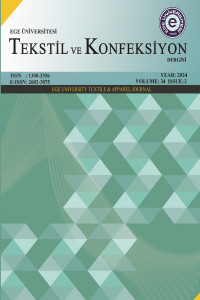Assessing the Height, Width and Other Parameters of Elliptical Yarn Cross-Section Through the Thickness of Orthogonal Fabrics
Abstract
This research focuses to assess the height, width, and other parameters of the elliptical yarn cross-section of woven fabrics through the new methodology. Hence this research studies the Elliptical Cross-Section of the yarn through the orthogonal fabric. Because in orthogonal fabric, the weft series stay straight. The samples of orthogonal weaves are produced using different counts of weft yarns. The thicknesses of orthogonal fabrics are estimated. The method of calculating the height of yarn from the thickness of the orthogonal fabric is evolved. The height of different counts of weft yarns used in weaving the orthogonal fabrics is calculated. From the height of the yarn, the width of the yarn is calculated. The height and width of the yarn are compared with the diameter. The comparison shows that the cross-section of the yarn remains elliptical in the fabric. The equations for calculating the flattening and bulging percentages are derived. It is observed that these two percentages are equal. It shows that when the yarn cross-section becomes elliptical in the fabric, the amount of flattening makes the yarn get bulge to the same amount in its width. The constant of height and constant of width are also derived. These constants are equated with the constants of diameter. The study also derived the equation to calculate the height and width of the elliptical cross-section of the given yarn count using the constants. The height, width, and diameter of different yarn counts are compared. The increase/decrease in flattening percentage between the coarser-finer yarns, single–2 ply yarns, and single-folded yarns are examined. It is suggested that the height and width of yarn assessed from the thickness are used to assess the other specifications viz. crimp percentage, cover percentage, and GSM of the fabrics.
References
- 1. Afrashteh, S., Merati, A.A., Jeddi, A.A.A. 2013. Geometrical parameters of yarn cross-section in plain woven fabric. Indian Journal of Fibre & Textile Research, 38(2), 126-131.
- 2. Behera, B.K., Mishra, R., Militky, J., Kremenakova, D. 2012. Modeling of Woven Fabrics Geometry and Properties, In Han-Yong, J. (Ed.), Woven Fabrics, Intechopen: Croatia, pp. 10-15.
- 3. Behera, B.K., Mishra, R. 2008. 3 – Dimensional Weaving, Indian Journal of Fibre & Textile Research, 33(4), 274–287.
- 4. Bogdanovich, A.E., Mohamed, M.H. 2009. Three-dimensional reinforcements for composites, SAMPE Journal, 45(6), 8-28.
- 5. Estaire, J., Santana, M. 2018. Large Direct Shear Tests Performed with Fresh Ballast. Stark, In T., Swan, R., and Szecsy, R. (Eds.), Railroad Ballast Testing and Properties, ASTM International, Conshohocken, pp. 144–161.
- 6. Grosicki, Z.J. 2004. Watson’s Textile Design and Colour, Woodhead Publishing Limited, Cambridge, England.
- 7. Khokar, N. 1996. 3D fabric-forming processes: distinguishing between 2D-weaving, 3D-weaving and an unspecified non-interlacing process, Journal of the Textile Institute, 87(1), 97-106.
- 8. Kovar, R., Kyosev, Y. 2004. Limit packing density of woven fabrics, Romanian Textile Journal, 1, 35-42.
- 9. Narkhedkar, R.N., Kane, C.D. 2012, Study of yarn cross-section shape and its diameter, The Indian Textile Journal, 4(6), 36-40.
- 10. Panneerselvam, R.G., Rathakrishnan, L., Vijayakumar, H.L. 2015. Weaving ‘figured-face flip face-fabric’using orthogonal weft tapestry weave, Indian Journal of Fibre & Textile Research, 40(4), 320–328.
- 11. Turan, R.B., Okur, A. 2012. Variation of the yarn cross-section in fabric, Textile Research Journal, 82(7), 719-724.
- 12. Unal, P.G. 2012. 3D woven fabric, In Han-Yong, J. (Ed.), Woven Fabrics, Intechopen, Croatia, pp. 91-120.
Abstract
References
- 1. Afrashteh, S., Merati, A.A., Jeddi, A.A.A. 2013. Geometrical parameters of yarn cross-section in plain woven fabric. Indian Journal of Fibre & Textile Research, 38(2), 126-131.
- 2. Behera, B.K., Mishra, R., Militky, J., Kremenakova, D. 2012. Modeling of Woven Fabrics Geometry and Properties, In Han-Yong, J. (Ed.), Woven Fabrics, Intechopen: Croatia, pp. 10-15.
- 3. Behera, B.K., Mishra, R. 2008. 3 – Dimensional Weaving, Indian Journal of Fibre & Textile Research, 33(4), 274–287.
- 4. Bogdanovich, A.E., Mohamed, M.H. 2009. Three-dimensional reinforcements for composites, SAMPE Journal, 45(6), 8-28.
- 5. Estaire, J., Santana, M. 2018. Large Direct Shear Tests Performed with Fresh Ballast. Stark, In T., Swan, R., and Szecsy, R. (Eds.), Railroad Ballast Testing and Properties, ASTM International, Conshohocken, pp. 144–161.
- 6. Grosicki, Z.J. 2004. Watson’s Textile Design and Colour, Woodhead Publishing Limited, Cambridge, England.
- 7. Khokar, N. 1996. 3D fabric-forming processes: distinguishing between 2D-weaving, 3D-weaving and an unspecified non-interlacing process, Journal of the Textile Institute, 87(1), 97-106.
- 8. Kovar, R., Kyosev, Y. 2004. Limit packing density of woven fabrics, Romanian Textile Journal, 1, 35-42.
- 9. Narkhedkar, R.N., Kane, C.D. 2012, Study of yarn cross-section shape and its diameter, The Indian Textile Journal, 4(6), 36-40.
- 10. Panneerselvam, R.G., Rathakrishnan, L., Vijayakumar, H.L. 2015. Weaving ‘figured-face flip face-fabric’using orthogonal weft tapestry weave, Indian Journal of Fibre & Textile Research, 40(4), 320–328.
- 11. Turan, R.B., Okur, A. 2012. Variation of the yarn cross-section in fabric, Textile Research Journal, 82(7), 719-724.
- 12. Unal, P.G. 2012. 3D woven fabric, In Han-Yong, J. (Ed.), Woven Fabrics, Intechopen, Croatia, pp. 91-120.
Details
| Primary Language | English |
|---|---|
| Subjects | Wearable Materials |
| Journal Section | Articles |
| Authors | |
| Early Pub Date | July 1, 2024 |
| Publication Date | June 30, 2024 |
| Submission Date | September 2, 2022 |
| Acceptance Date | November 23, 2022 |
| Published in Issue | Year 2024 Volume: 34 Issue: 2 |


